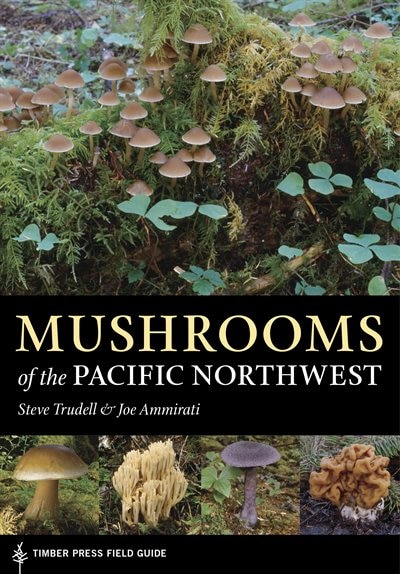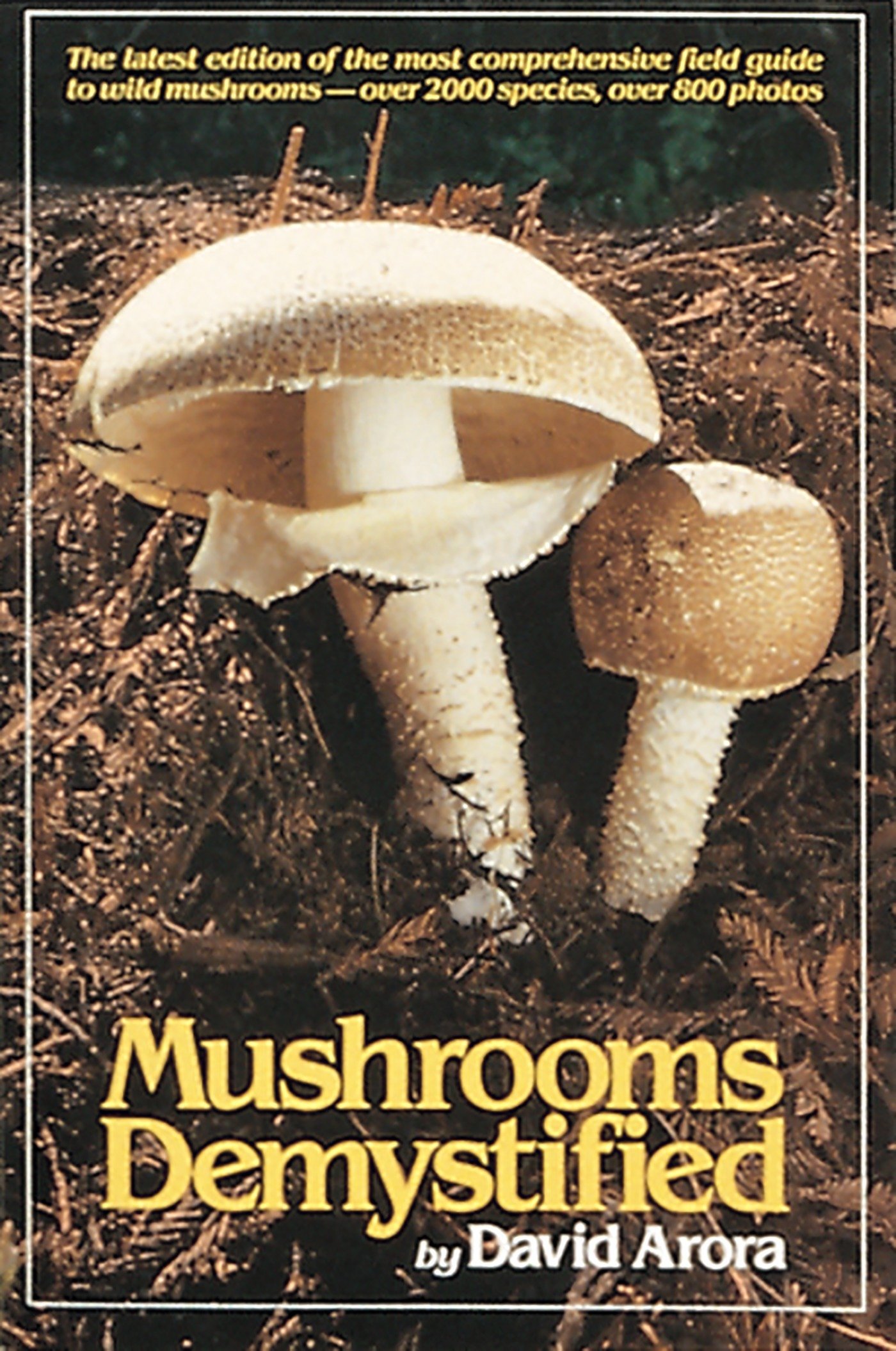Washington is an interesting state for any kind of naturalist, since it exists in two very distinct halves—the cloudy, forested, and mostly mountainous west and the dry, grassy east. The west side is more famous as a mushroom source, but both are worth a look.
Please do not harvest and eat wild mushrooms without the aid of an expert (unless you become and expert yourself!). It’s not that most mushrooms are all that hard to identify, it’s that becoming an expert makes a person more sensitive to subtle distinctions between species, making differences much more obvious. The whole process gets easier and safer. Plus becoming an expert in mushrooms is a lot of fun.
The following list is just a short sampling of the edible mushrooms growing in the state[i] and not to be used in place of a field guide, spore prints, or an identification app. Try and use a local expert in your area to help you when picking. If you go mushroom hunting make sure you take a quality knife with you and a basket/bag for your finds!
Our Recommended Field Guides for Washington
COVER | TITLE | Header | ||
|---|---|---|---|---|
OUR #1 RATED | ||||
Edible Wild Mushrooms in Washington
King Bolete (Boletus sp.)
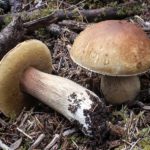
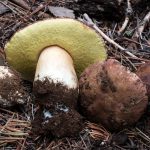
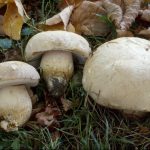
King bolete[ii] is the same thing as porcini, a large, almost meaty mushroom with pores rather than gills. It’s actually more than one species, and the taxonomy is still being figured out[iii]. The original name, Boletus edulis, will now apply to only one species in the group, and it’s not clear whether the kings growing in Washington are that one or not. The state also has two similar species, The Spring King (B.rex-veris), and The White King (B. barrowsii).
There are also other bolete species, both in the Boletus genus and not. Many are edible, but some are poisonous.
Chanterelles (Cantharellus sp. and others)

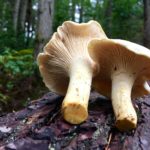

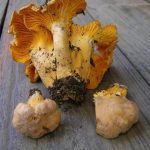
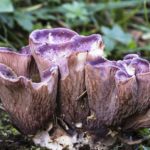
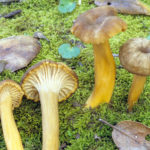
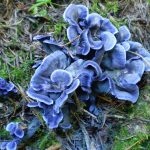
The Chanterelles are a group of distinctive-looking and delicious edible mushrooms. Most are in the Cantharellus genus, though there are some similar groups that sometimes also bear the Chanterelle name. There are a few poisonous look-alikes, but with a little attention to detail, the difference isn’t difficult to spot.
Washington has at least eight species[iv], four of which are in the Cantharellus genus: Pacific Golden Chanterelle (C. formosus), White Chanterelle (C. subalbidus), Cascade Chanterelle (C. cascadensis), and Rainbow Chanterelle (C. roseocanus). That last one isn’t rainbow-colored, unfortunately. It’s mostly orange. There’s also Pig’s Ears(Gomphus clavatus), Winter Chanterelle or Yellowfoot (Craterellus tubaeformis), and the Blue Chanterelle (Polyozellus multiplex).
Hedgehogs


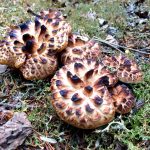
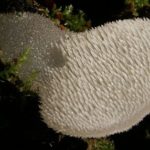
The Hedgehog Mushroom (Hydnum repandum) is a popular edible notable for the fact that it bears spines under the cap rather than gills or pores. It doesn’t grow in North America, although some otherwise excellent guides say otherwise—this is another case of what everyone thought was a single species turning out to be several[v]. North America has multiple Hedgehog species, though the taxonomy isn’t entirely worked out yet. Washington’s Hedgehog species seems to be, appropriately, H. washingtonianum. A similar member of the same genus in Washington is the Sweet Tooth (H. oregonense).
Two other species deserve mention in this group, though they aren’t closely related.
The Scaly Hedgehog (Sarcodon imbricatus)[vi] looks very much like a hedgehog mushroom but with large, dark, raised scales on the cap. Toothed Jelly (Pseudohydnum gelatinosum)[vii] looks very vaguely like a hedgehog mushroom, except it is translucent white with a gelatinous texture. Both are edible, though some people find the Scaly Hedgehog terrible-tasting—apparently this is not a difference of opinion about the taste, but an actual difference in perception, perhaps similar to the way cilantro tastes like soap to some. The Toothed Jelly is merely rumored to be bland.
Oyster Mushrooms (Pleurotus sp.)
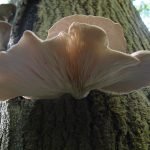
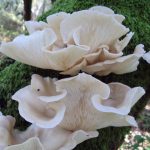
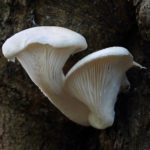
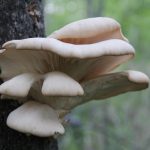
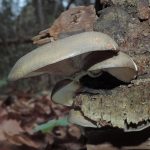
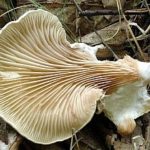
The name “oyster mushroom” can mean either Pleurotus ostreatus, which does grow in Washington, or it can mean any member of the Pleurotus genus—usually these other oysters get a descriptive adjective in their common names. Washington’s other oysters include Summer Oyster (P. pulmonarius), Veiled Oyster (P. dryinus), and Aspen Oyster (P. populinus)[viii]. All are choice edibles, but the name is a reference to their appearance—they don’t taste like shellfish.
The oysters have a number of look-alikes that are variously poisonous, inedible for other reasons, or simply untested. But there are also a few look-alikes that are edible, at least with some caveats. The Late Fall Oyster (Sarcomyxa serotina)[ix] is much tougher than any true oyster mushroom and must be cooked on low heat for a long time to soften. Angel wings (Pleurocybella porrigens)[x] are reportedly very enjoyable, but eating them killed 13 people in Japan in 2004, so many authorities now list the species as poisonous. Yet the vast majority of those who eat Angel Wing Mushroom don’t get sick. Clearly caution and some research is in order.
Puffballs
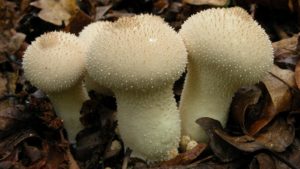
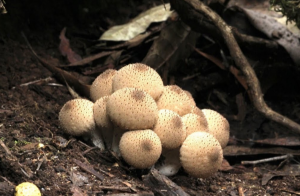
Puffballs are a large group of mostly unrelated species whose fruiting bodies are roughly ball-shaped. The spores develop inside the ball, which ruptures or opens a pore at maturity to puff the spores out. Most are edible before the spores start to mature, though care must be taken to avoid mistaking a poisonous Earthball or the egg-stage of a deadly Amanita for an edible puff!
Washington has at least three species, the Gem-Studded Puffball (Lycoperdon perlatum), the Stump Puffball (Apioperdon pyriforme, previously called Lycoperdon pyriforme), and the Western Giant Puffball. The latter is a challenge to forage, because their protein content is so high that it must be refrigerated after harvest, like meat, but they are typically too big to fit in the fridge. Perhaps part can be cooked right away, leaving only a smaller portion for the fridge? They do dry well. Don’t harvest these without a plan.
Morels (Morchella sp.)
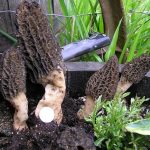
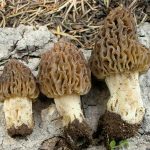
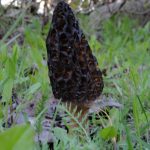
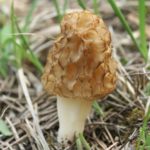
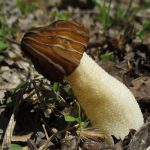
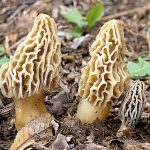

The Morels are a group of distinctive-looking and delicious mushrooms all in the same genus, Morchella. They share, among other features, a long, very narrow cap that is densely pitted like honeycomb. Unfortunately, the taxonomy of the group is in flux[xi], which may be why one respected source says Washington has two species (M. importuna and M. snyderi), while an older study lists a completely different five (M. elata, M. esculenta, M. populiphila (Formerly thought to be M. semilibera but due to DNA testing M. semilibera has been proven to be in Europe only), M. deliciosa, and M. crassipes)[xii]. Suffice it to say that Washington has morels.
Caveats are in order. First, morels do have poisonous look-alikes. Second, morels may themselves be poisonous, at least for some people. It’s not clear why some people get sick and others don’t.
Western Cauliflower (Sparassis radicata)
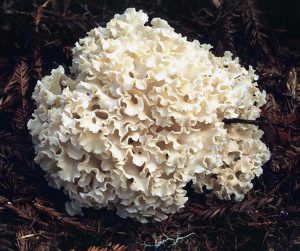
The Western Cauliflower Mushroom[xiii] is named for its appearance, although a heap of plain, cooked, wide Chinese noodles might be nearer the mark than a cauliflower head. These mushrooms are a choice edible with a single draw-back; the dense and much-branched “noodles” are very difficult to clean.
Magic Mushrooms in Washington
Washington state has an unusually long list of psychoactive mushrooms. Unfortunately, possessing or ingesting these is still against both Federal and state law. Seattle has decriminalized Psilocybin Mushrooms[xiv], meaning city police won’t put much effort into arresting people for its use—but it’s not actually legal. Not yet. Watch out. That being said, there is no law against looking.
Gymnopilus sp.
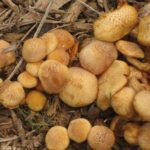


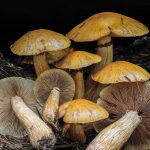
Only a small minority of the species in the genus, Gymnopilus[xv] are “active,” and not much is known about them. Washington state does have four of these actives, though: G. aeruginosus, G. braendlei, G. luteofolius, and G. viridans
Panaeolus sp.
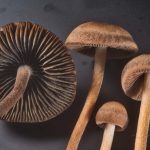
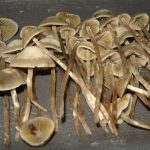
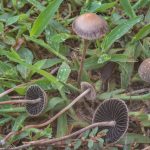
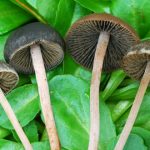
Panaeolus mushrooms are also called Mottlegills, since their spores mature and darken unevenly, producing dark spots on the gills. There are both active and inactive members of the genus. Of the actives, some are very mild while others are extremely potent. Washington hosts four active “pans:” P. cinctulus[xvi], P. bisporus, P. fimicola, and P. olivaceus
Psilocybe

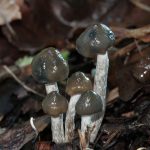

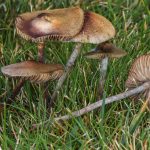
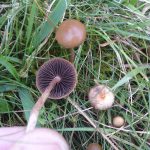
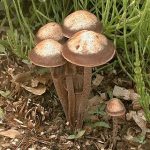
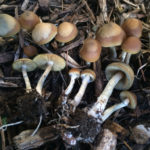
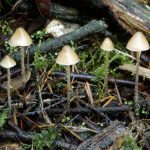
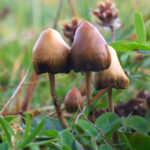
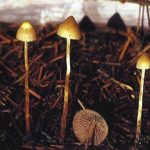

Psilocybe is perhaps the most famous psilocybin-containing genus, perhaps because it contains the most famous magic mushroom, P. cubensis, a favorite for microdosing but a species that does not grow (except in indoor cultivation) in Washington. However, a whopping eleven others do! Ready for the list?
Psilocybe azurescens
Psilocybe baeocystis
Psilocybe cyanescens
Psilocybe cyanofibrillosa
Psilocybe fimetaria
Psilocybe liniformans var. americana
Psilocybe ovoideocystidiata
Psilocybe pelliculosa
Psilocybe semilanceata
Psilocybe silvatica
Psilocybe stuntzii
Whew!
Poisonous Mushrooms in Washington
There are a lot of poisonous mushrooms—and many whose safety simply isn’t known. No one should assume that a mushroom is safe just because it’s not on this list! These are just some of the most notable and most dangerous[xvii].
Deathcap (Amanita phalloides)
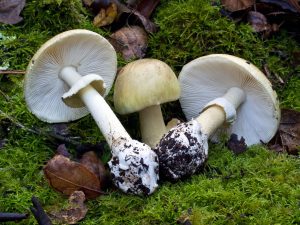
The Deathcap is one of the most deadly mushrooms on the planet—in part because it has been used as a murder weapon. More commonly people eat it after mistaking it for something else, or out of simple curiosity. It’s a large and handsome mushroom with a greenish-brownish cap, and it’s common in some urban and suburban areas. Most people who do eat it die. Hope is not lost, though; some do survive with prompt and knowledgeable treatment.
Smith’s Anamita (Amanita smithiana)
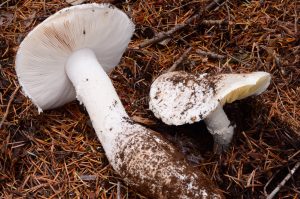
Smith’s amanita[xviii] is not as deadly as some of its relatives, such as the Deathcap, but it can kill human eaters. It’s sometimes mistaken for Matsutake, a prized edible. Smith’s Amanita has distinctive, cottony veil fragments around the outer rim of the cap when young, but these often fall off with age.
Deadly Galerina (Galerina marginata)

The Deadly Galerina, on the other hand, is just about as deadly as a Deathcap, since it contains the same toxins in similar quantity. It’s a LBM (“little brown mushroom”) a large group of mostly unrelated, nondescript mushrooms easily mistaken for each other. Other LMBs include several popular edibles as well as most of the “magic” mushrooms. Worse, it shares a habitat with some of its look-alikes, sometimes even growing among them.
False Morel (Gyromitra esculenta)
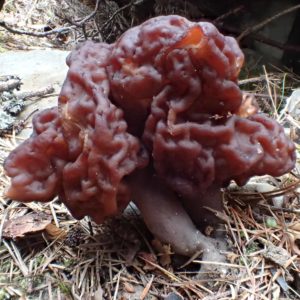
False morels[xix], as the name implies, look a bit like morels, though the resemblance is slight—G. esculenta (or its look-alikes, as this could be another group mistaken for a single species) species is among the most morel-like. Most people who eat false morels do so on purpose, though, since these are among the odd species considered both seriously toxic and popular for the table. The problem is that many people don’t get sick from eating these mushrooms, while others very much do. The amount of toxin may vary, plus the toxin may be cumulative, meaning it’s possible to eat False Morels for years without trouble and then suddenly get extremely ill. Parboiling removes some of the toxin, but not likely all of it.
Brown Rollrim (Paxillus involutus)

The Brown Rollrim[xx]—which looks rather like a clumsy first draft of a Chanterelle (though it has gills, not a Chanterelle’s ridges). It is toxic, though only rarely deadly. Cooking removes one of the mushroom’s toxins, but a second toxin remains. Worse, the second toxin is cumulative, so eaters may appear to be enjoying the mushroom safely without ill effect, when really the poison is building up in their bodies and will eventually cause serious symptoms very suddenly.

My name is Austin Collins.
I've dedicated my life to Mushrooms.
I believe Mushrooms are the best kept secret when it comes to health and well being.
For that reason, I would like to share a company with you that in my opinion makes the best mushroom products on the market.
The company is called Noomadic Herbals, my favorite supplement they make is called "Mushroom Total".
I take their products every day and they have helped me think better and have more energy. Give them a try.
-Austin
References:
[i] (n.d.). Wild Edible Mushrooms of Washington. Northern Bushcraft
[ii] (2011). King Bolete (Boletus edulis and others). Mushroom-Collecting
[iii] Scates, K. (2019). Trial Field Key to the Boletes in the Pacific Northwest. SVIMS
[iv] Sage, T. (2011). Species List: Chanterelles of Washington State (250). Mushroom Observer
[v] Kuo, M. (2020). Hydnub repandum. MushroomExpert
[vi] Aon, O. (2021). Hawk’s Wing or Scaly Hedgehog, Sarcodon imbricatus. Forage Colorado
[vii] Emberger, G. (2008). Pseudohydnum gelatinosum. Messiah University
[viii] (n.d.). Oyster Mushroom. Northern Bushcraft
[ix] Emberger, G. (2008). Sarcomyxa serotina. Messiah College
[x] Winkler, D. (2019). Pacific Northwest. Mushroaming
[xi] Kuo, M. (2012). The Morchellaceae: True Morels and Verpas. MushroomExpert
[xii] (n.d.). Research Projects. Puget Sound Mycological
[xiii] Wood, M., Stevens, F.(n.d.). California Fungi—Sparassis radica. The Fungi of California
[xiv] Van Streefkerk, Mark (2021). Seattle’s Mushrooms (Magic and Otherwise) Have Arrived. Eater Seattle
[xv] (n.d.). Gymnopilus. Wikipedia
[xvi] (n.d.). Panaeolus cunctulus. Philosophy
[xvii] Sage, T. (2011). Species List: Deadly or Potentially Deadly Mushrooms of the Pacific Northwest (221). Mushroom Observer
[xviii] Wood, M., Stevens, F. (n.d.). California Fungi—Amanita smithiana. The Fungi of California
[xix] Volk, T.(2002). Gyromitra esculenta. Tom’s Fungi
[xx] (n.d.). Paxillus involutus (Batsch) Pers.–Brown Rollrim. First Nature



